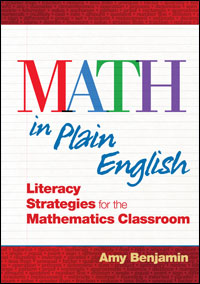Marrying Math & Literacy
Math in Plain English: Literacy Strategies for the Mathematics Classroom
by Amy Benjamin
(Eye on Education/Routledge, 2011 – Learn more)
Finally, a book that makes connections between math and literacy learning!
Math in Plain English: Literacy Strategies for the Mathematics Classroom by Amy Benjamin focuses on math comprehension — aka, understanding math — not just doing math. Math in Plain English is about combining what we know about math problem-solving and math thinking with literacy strategies that consistently support students to persevere and succeed in mathematics.
Benjamin opens with a User’s Guide that translates and connects the Common Core Standards for Mathematical Content and Practice to the four modes of language: reading, writing, listening, and speaking. She emphasizes receptive language (listening, reading) and productive language (speech and writing) in math, reminding us that productive modes develop after, and as a result of, receptive ones.
As Benjamin points out, traditional math instruction is typically heavy on receptive tasks (teacher work examples, notes on the board, assigning math chapters as reading) and can lead to shallow learning. Benjamin challenges the teacher-reader to incorporate both receptive and productive math instruction into the curriculum to make math meaningful and memorable.
Literacy & Math comprehension

The book’s thesis, tapping into the language of math, is supported through 10 strategies that create a strong organizational format for readers to follow. From “Teaching Mathematical Words Explicitly” to “Preparing Students for Algebraic Thinking,” Benjamin invites readers to support traditional math instruction by teaching math as a language.
She ties this idea to language acquisition theory, citing its key components. The premise is that students must interact with and be immersed in the language and meaning of math, working from the known to the unknown. She addresses the challenges of math through exploration of context, etymology, background knowledge, writing, discussion, listening, and monitoring strategies.
My highlighting
Here are highlights I gleaned from each of the ten strategies Benjamin recommends:
• Teach mathematical words explicitly. Etymology illuminates meaning, and students will learn to “speak math fluently.”
• Teach math implicitly. Immerse students in math language through natural exposure and opportunities for use over time.
• Teach reading-in-math as an integral problem solving skill. Reading text in math is much slower and more recursive than reading literary text.
• Teach math through many paths. Metaphor and gesture foster abstract-to-concrete translation.
• Teach language as the key strategy for solving word problems. Do not rely on unreliable shortcuts.
• Teach note-taking. The purpose of notes in math is to help students focus as they listen and to assist them in the future.
• Use formative assessment to determine the next steps in instruction.
• Commentary is a more effective way to provide students with feedback than numbers/scores.
• Teach knowing versus memorizing. Students need to develop a mental model and have the ability to generate examples of their own.
• Writing causes learning.
• Create links to algebra from the very beginning.
Rich with activities, examples & free downloads
Many teachers will relate to Benjamin’s anecdotes about her personal struggle with math, and her acknowledgement that math teachers may not also be English teachers (depending on the grade). This is where her many suggested activities, examples, vignettes, and free downloads come into play — offering support for teachers with math or language arts specialties, and for those who wear both hats.
I appreciated the author’s strong examples of strategies that work as well as strategies that do not (for example there are times when memorization is useless or when context is imperative to understanding a problem). Math in Plain English does not simply tell educators what to do but provides supportive and varied examples. Hmm — this may be a metaphor for learning math!
Where might a math teacher’s eyes glaze over? The focus on word etymology in the first few strategies might cause some trepidation, but Benjamin does a good job introducing activities for even the most reluctant to try. The study of explicit and implicit word meaning will at least get a teacher thinking about making connections in math. And it may answer the question, “Why can students do the problem but not understand it?” Personally, I did not find the word analysis strategies off-putting, but I was an English teacher. Mix my math with some grammar and I’m giddy!
After reading this book, readers are ready to support students to close the gap between what they do and what they think in math. Math in Plain English provides background and evidence grounded in current research, and it challenges us to consider not only content, but the impact of language on math learning. Readers are empowered to delve beyond shallow learning into the deep waters of student achievement.
Shelly Sims has been an educator for over 20 years. She began her career in the elementary grades and is a Reading Recovery® teacher. Her experience as a literacy coordinator inspired a move to middle school where she taught language arts, social studies and science. She is a seasoned presenter (including a workshop in Abu Dhabi, pictured above) and a current graduate student. Presently, Shelly is Academic Initiatives Mentor at Pine Lake Preparatory in North Carolina.






























